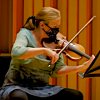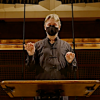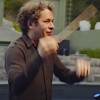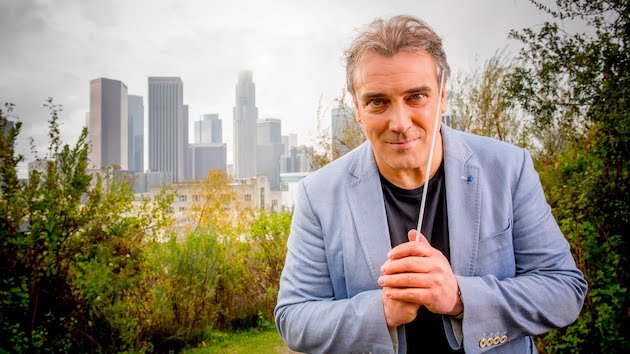
I counted them. Between Nov. 30 and Dec. 1, I received 24 invitations to view performances online from symphony orchestras, opera companies, chamber orchestras, recitals, dance companies, performing arts centers, a piano competition, and three webinars. Add the online concert round-up posted right here at SFCV and the number skyrockets.
With the long-awaited vaccine on the horizon, a return to the concert hall begins to seem possible. But in the meantime, the internet remains the platform for all of the performing arts. That reliance has stimulated organizations to produce higher and higher quality content and push the creative envelope.
Two recent projects that stand out are Throughline: San Francisco Symphony — From Hall to Home, which premiered on Nov. 14 conducted by Esa-Pekka Salonen; and the Los Angeles Chamber Orchestra’s Close Quarters — a 16-episode virtual season that debuted on Nov. 6. Both projects feature state of the art examples of performance capture and video imagery.
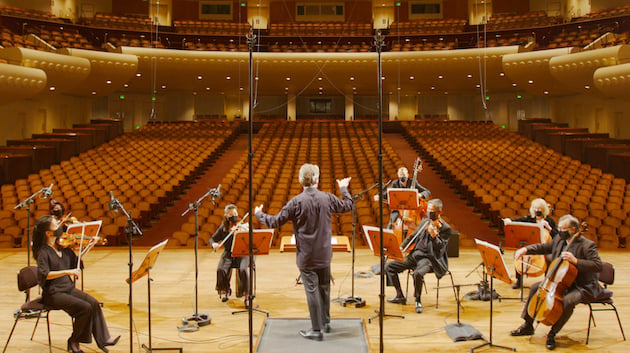
In conversations with San Francisco Symphony’s CEO Mark Hanson, Head of Digital Innovation Oliver Theil, Chief Programming Officer Matthew Spivey, along with LACO Executive Director Ben Cadwallader and Director of Visual Content James Darrah, there was unanimous agreement that at this moment it is essential to produce the best possible online offerings. They also had a good deal to say about issues of visual and musical content, the opportunity the internet provides to widen diversity and reach new audiences, as well as a desire to determine metrics for measuring success.
“It’s a bit of a fallacy to think of the relationship between performing arts and media as a zero-sum game,” observes Matthew Spivey. “It’s true that everyone has a finite amount of time to spend online and can’t possibly consume everything that’s out there. There is definitely an element of competition. But with the influx of such a variety of performing arts media, the volume and the quality has greatly increased and that seems to be stimulating more people to consume the arts. What it boils down to is creating your own artistic profile and identity.”
Protocols and Empty Seats
From the moment the COVID-19 shutdown occurred, and any hope of quickly returning to the concert hall faded, it became clear that the internet was the only usable performance space. Those early living room Zoom recitals, however, were pretty crude.
“Initially,” Mark Hanson recalls, “The only content we could offer was of a homegrown nature. But I do think people appreciated seeing those broadcasts of musicians playing in their living rooms. Those Zoom-style collaborations were a unique and immediate response to the pandemic.”
Ben Cadwallader remembers those days as a crash-course in survival.
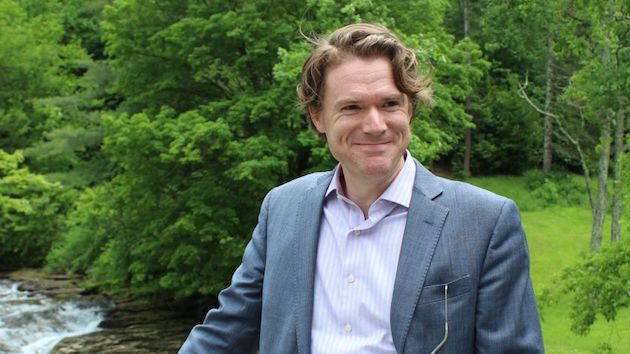
“It was the Wild West!” he says. “Everyone’s message was the same: We’re still here, and we’ll get through this together. We were all in triage mode.”
As the long-term implications of canceled seasons sank in, organizations like the San Francisco Symphony and the Los Angeles Chamber Orchestra began to reevaluate their internet presence, as well as the rising tide of online competition. Fortunately, they had both been financially able to maintain the employment of their musicians, though at a significantly lowered pay scale. That meant that, when the moment came, they were able bring together their musicians, who were all anxious to perform.
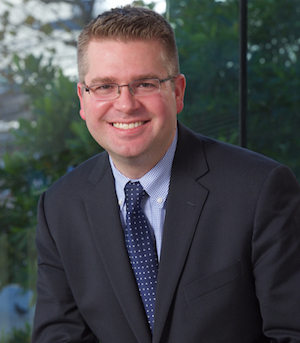
“Orchestras are emotionally and contractually linked to their musicians,” Spivey explains. “Creating digital content provided a way to utilize an asset the organization was already paying for. Technically, our musicians were on call.”
The really important step was the establishment of state-approved health protocols, a process spearheaded by a Hollywood film industry desperate to get musicians back to the soundstage. This union-negotiated agreement also helped orchestras because under the protocols their work became grouped under the umbrella performance capture.
That led to San Francisco Symphony streaming its Keeping Score series while LACO launched its SummerFest recital programs. The Los Angeles Philharmonic began its series of SOUND/STAGE concert recordings, conducted by Gustavo Dudamel on the vast stage of the Hollywood Bowl. In each case, social distancing, COVID-19 testing, the wearing of face masks for string players, and Plexiglas isolation for winds and brass players became the norm. Halls, however, remained vacant of audiences, prompting LACO’s concertmaster Margaret Batjer, at the end of a particularly spirited recording session, to comment “the silence was deafening.”
Improving the Online Experience
Performance capture stimulated a quantum leap in recording quality.
“Early on our new music director, Jaime Martín, said ‘Enough of the Zoom concerts! We are a professional orchestra. It’s all about the quality of our performances. We need to think beyond what we’re doing,’” Cadwallader recalls. “We dialed up the production quality. We hired professional crews, video editors, and started to invest in our digital infrastructure and marketing campaigns. Essentially, we had to become a media company.”
The transition was easier for the San Francisco Symphony. In fact, the organization had been turning to electronic media as the way out of a crisis since 1926! In that year, desperate and on the verge of bankruptcy, the orchestra struck a deal with the Standard Oil Company of California. The oil giant would pay off the orchestra’s debts in exchange for the broadcast rights to the upcoming season of concerts. The first Standard Symphony Hour radio broadcast took place on Oct. 24, 1926. It saved the Symphony and became so popular it ran for more than 30 years.
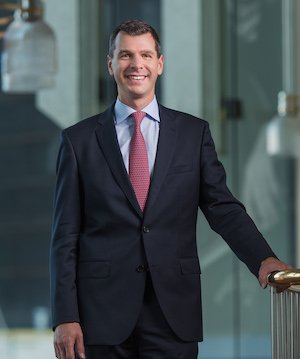
“We’ve been on the leading edge of media a long time going back to those first syndicated radio broadcasts,” Hanson emphasizes. “We launched our own in-house audio and video production label, SFS Media, 20 years ago. But the pandemic necessitated a shift for every arts organization. At first, there was the need to produce content with very fast turnaround. That was a shift that required investment and reexamining the role digital played. The challenge was 1) To be creative within the protocol format; 2) Assume an active part in the current social conversation while keeping in touch with contemporary composers we wanted to expose audiences to; 3) Expand our partnering with media outlets and the diverse community of artists that exists throughout the Bay Area.”
“Prior to the pandemic there was already an active discussion about our use of digital media,” points out Theil. “We knew it was going to play a big role in our development moving forward. But when the pandemic put a halt to all other forms of activity, it gave us the chance to focus 100 percent on developing our digital content. We were also exceedingly fortunate because our new music director, Esa-Pekka Salonen, had been at the epicenter of digital innovation long before the pandemic.”
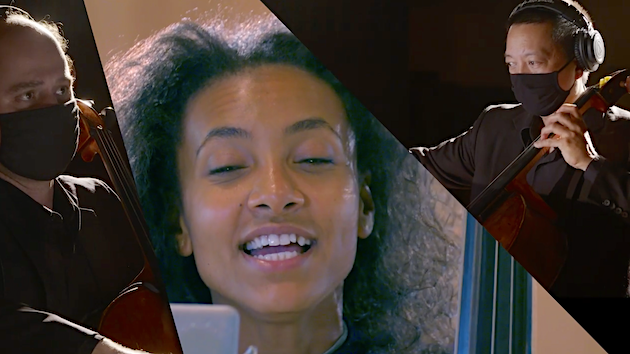
On Nov. 14, the San Francisco Symphony unveiled Throughline as “a virtual opening night gala” featuring various configurations of the orchestra conducted by Salonen. It also emphasized contributions from the eight members of Salonen’s collaborative partners: Nicholas Britell, Julia Bullock, Claire Chase, Bryce Dessner, Pekka Kuusisto, Nico Muhly, Esperanza Spalding, and Carol Reiley. The program itself was wide ranging, from the Allegro con brio movement of Beethoven's String Quartet in F Minor, Op. 95, to a crossover star turn by Oakland rapper Kev Choice, featuring AIMA the DRMR. The climax clearly was the world premiere commission of Nico Muhly’s Throughline, which gave name to the series, a piece that could have been subtitled “A Guide to the Orchestra.”
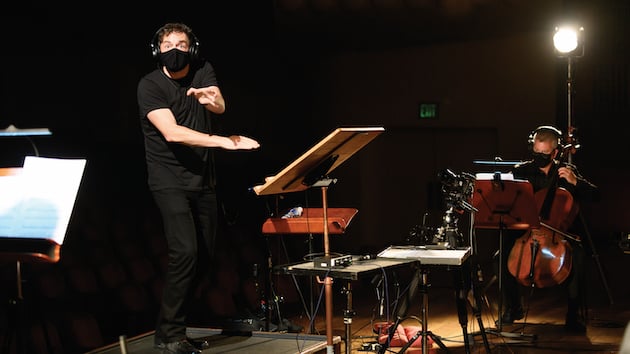
“The inventive nature of Nico’s proposal was critical to the success of the program,” explains Theil. “It allowed us to use a large segment of our orchestra onstage at Davies Symphony Hall one-by-one or in small groupings. Then we combined shots of the partners filmed in locations around the world. The idea was to pretend we were all in the same room taking part in a live concert experience. In post-production it was all carefully edited together. It took months to plan, capture, and produce.”
At the same time that Throughline was in production, LACO was looking for an innovative director to take the orchestra to its next level of digital production.
“We realized we needed to make a change. We didn’t want to show anymore concert halls filled with empty seats,” recalls Cadwallader. “We knew we weren’t maximizing our potential. That’s when I spoke to our new composer in residence, Ellen Reid. I asked Ellen who we should be talking to. She suggested James Darrah, who had directed her Pulitzer Prize-winning opera, prism. She described him as ‘someone you want to be with at the end of the world,’ who can take problems that seem insurmountable and weave them into art.”
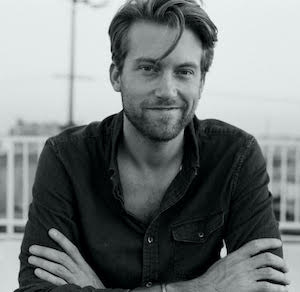
Darrah, however, was not immediately enthusiastic. Having worked predominantly in opera, he wasn’t sure a traditional classical orchestra would be open to a change in format. A graduate of UCLA’s school of Theater, Film, and Television, Darrah’s primary requirement was that the new series (that would come to known as Close Quarters) would take an interdisciplinary approach that would combine orchestral performances with elements of film, video, dance, and fine art.
The performance captures would be recorded at the Colburn School (in downtown LA) while the visual elements would be recorded separately at Wilhardt & Naud — a vast former industrial warehouse in Chinatown that had been converted into a multidisciplinary arts campus.
“Our goal was not to recreate a traditional season but to create something uniquely visual specifically to live online,” Darrah explains. “The interplay of the images and ideas were meant to be fluid, not really scripted, so it could evolve over the course of the 16 episodes. We thought it was important to feature composers that had LACO premieres canceled, as well as fine artists that had gallery exhibits canceled and dancers that weren’t able to perform. We wanted to bring them all together in this new digital sphere.”
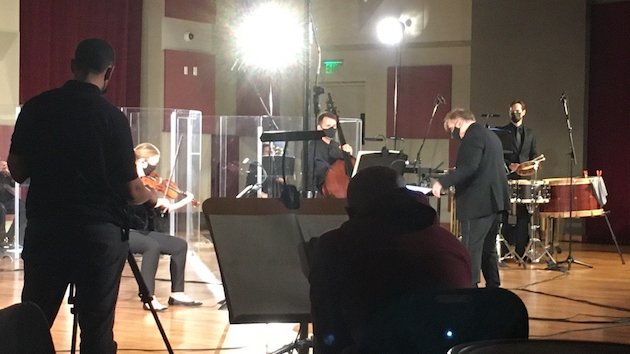
When the first episode of Close Quarters (titled Border Crossings) aired on Nov. 6, it was unquestionably original, interpolating performance capture with a style of abstract video you might expect to encounter at the Getty Museum.
The question was, would it sell? Darrah was hopeful but skeptical.
“There is a safe element to the way classical music is traditionally marketed,” he feels. “It’s designed to please a very specific base audience and appease donors. I think, at least with the opera organizations I’ve worked with, they want to feel their institutions are branching out into pop culture and collaborating with people that haven’t necessarily been part of the classical music sphere. Some of the artists and dancers I contacted to take part in Close Quarters didn’t even know there was a Los Angeles Chamber Orchestra. That’s why I think this series has is a lot of potential for collaboration and developing new audiences. It’s a chance to rewrite the rules.”
How do you measure success?
The problem with the internet is it’s a one-size-fits-all platform. During the pandemic it has principally provided organizations with a way to stay connected to subscribers and patrons while maintaining brand presence. It has not generated anything resembling a revenue stream, since the vast majority of content is offered for free. Which raises an intriguing question: Without income as a monetary metric, how can musical institutions like the San Francisco Symphony and the Los Angeles Chamber Orchestra measure success?
“To this point we have offered all our content for free,” Hanson observes. “In the future it will be interesting to see what type of mix of free and pay-per-view we come up with. We are looking at ways to monetize at least some of our digital content. But as yet that has not been our focus. We have been more interested in getting content in front of as many audiences as possible.
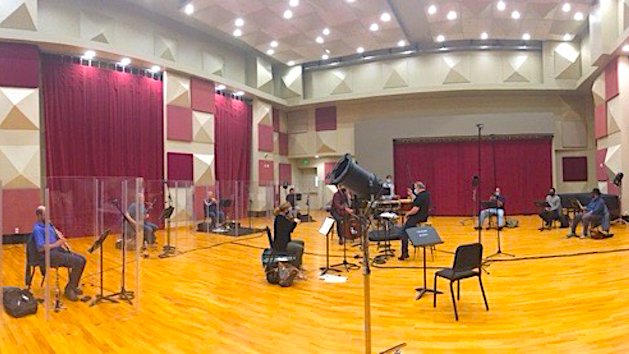
“Right now, we’re gathering metrics based on pageviews and ratings from our television broadcasts as well as anecdotal feedback from monitoring all our social media channels. That gives us real-time quantitative responses about how people are experiencing our digital content.”
According to Cadwallader, LACO’s metrics indicate that there is another significant factor that is affecting viewership — “online COVID fatigue.”
“Connecting with our patrons we’ve found there is a definite element of online fatigue. In fact, many of our members have simply stopped watching. That’s terrifying, because our early attempts to stay connected were watched and recognized. Nine months into the pandemic, people are telling us they just can’t do it anymore. They just don’t like watching on their computer. The truth is many of those people won’t come back until we can offer live concerts.”
But, Cadwallader points out, when one door closes another can open.
“We’re hoping Close Quarters reenergizes those viewers. And out viewing numbers so far are very encouraging, in the thousands. At the same time, those metrics have freed us up to explore a more adventurous formula. YouTube can be the perfect space for us to reach out and develop a whole new target audience.”
While the pageviews for the first episode of Close Quarters was in the thousands, the response from LACO’s subscriber base was not all-embracing.
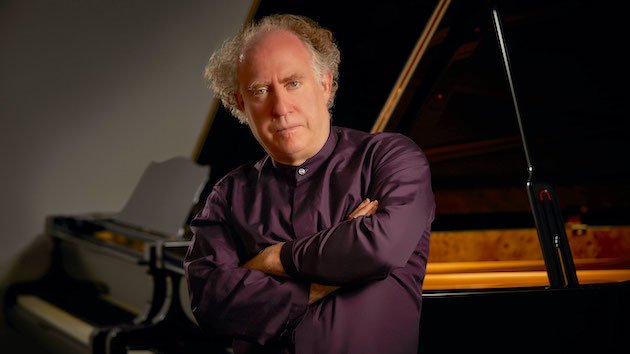
“The blowback was not so much against the formula,” explains Cadwallader. “The question asked most often was why [were] the musicians not on screen more? That was a fair question. So, in episode two there is a great deal more effort to show the musicians. What those two episodes did for us was create a spectrum between abstraction and direct performance capture. Over the course of the season, you’ll see that balance shift in both directions. When we have Jeffrey Kahane and Jaime Martín performing Bach’s Brandenburg Concerto No. 5 [on Dec. 18 at 6:30 p.m.] their artistry will definitely be the primary focus. On the other hand, when we post our New Year’s Day episode, it’s going to be presented as a narrative short film.”
Bowing to its members’ request, LACO has also begun to offer an alternative stream that allows viewers the option to watch the performance capture without the additional visuals.
“A good deal of the feedback we’ve received after the premiere of Throughline,” says Hanson, “was that people never expected this kind of content from the San Francisco Symphony. They hope this is not just a temporary shift in our programming philosophy. We read that as a desire for us to make a commitment to offer digitally creative content for years to come.”
NB: LACO Concertmaster Margaret Batjer's name was misspelled in the original version of this article. We regret the error.


